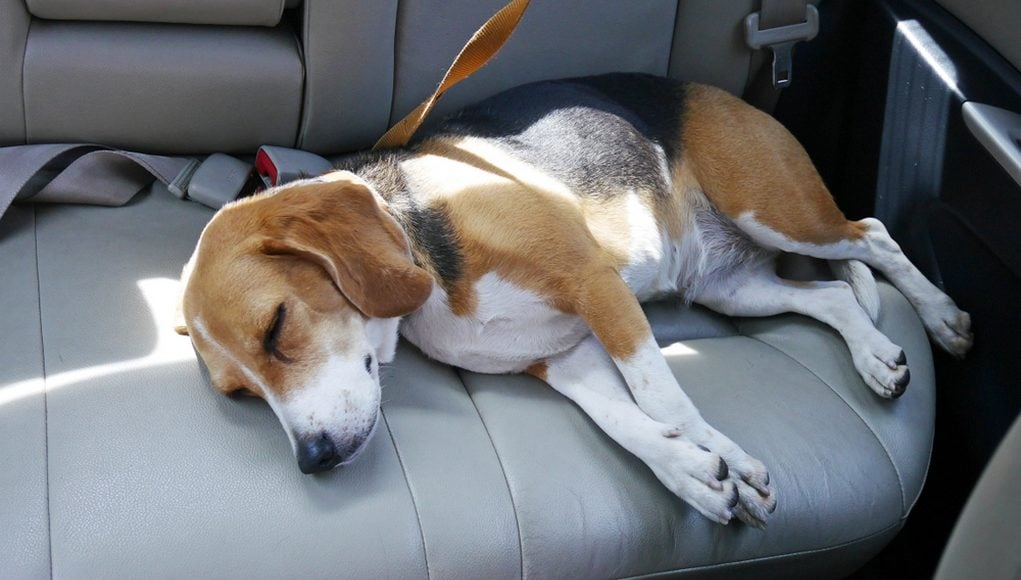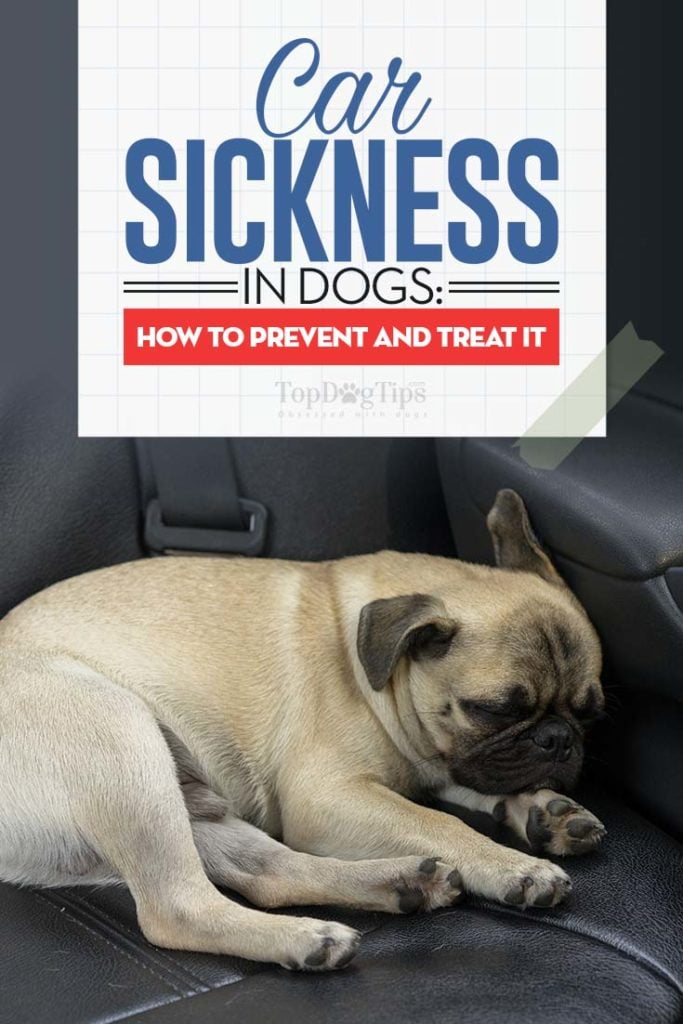Table of Contents
Your dog becomes nauseous or even vomits every time you go for a ride. But is dog car sickness a real thing, and do dogs actually get motion sickness the way people do?
Yes. Just like people, dogs do get motion or car sickness, and it's more common in puppies than adult dogs because their inner ear parts haven't properly developed yet. Usually, dogs will outgrow this by the time they're approximately 1 year old, but that's not always the case.
There are two common reasons for a dog's car sickness: (1) true motion sickness related to inner or middle ear infections such as vestibular disease, or (2) some type of travel or car anxiety. It has also been suggested that some dogs who have motion sickness are triggered by an absence of early handling by people.
Signs of Dog Car Sickness
When you take your dog out for a spin in a car, be sure to be on the lookout for signs and symptoms of dog's car sickness such as:
- listlessness, uneasiness or inactivity
- yawning
- whining
- excessive drooling
- vomiting
- licking lips or smacking lips
Once you spot the signs, you should stop the car and get your pooch out for a quick walk to relieve the stress. If you're using a dog car seat, you can also place your pooch in the front seat since that usually helps to relieve motion sickness in both animals and humans.
However, even though your dog may experience fewer visual disturbances while riding in the front seat, be warned that air bags pose a serious risk to your dog.
How to Treat and Prevent Your Dog's Car Sickness
Conditioning the dog for car rides is probably the most effective way to treat dog car sickness. To accomplish this, start taking short car trips every day, gradually increasing the time of the ride. Begin simply by allowing the dog to get comfortable in a non-moving vehicle, then keep increasing the ride length in 5-10 minute increments until your pooch is fine riding for 1-2 hours.
You can also try making your dog's car ride more comfortable and steady. For example, getting your dog strapped into a car seat will prevent them from sliding in the backseat, and will also keep them staring in a more focused direction, which generally helps with car sickness.
During a ride, try lowering car windows a few inches while you're in motion. This helps to balance the car’s internal air pressure as well as bring fresh air inside, which may help reduce your dog’s unpleasant sensations like nausea.
Always keep the car cool by opening windows and/or running AC. Play classical music, since it's been shown in studies to calm dogs down and ease their anxiety. Bring a scent article, such as a blanket or t-shirt that smells like home to keep the environment familiar for the dog.
If possible, avoid having your dog sit in the backseat because the side windows that provide the dog with a whizzing view are often the cause of car sickness. You can try installing a console car seat, which helps to bring your dog close to looking ahead instead. If not using a car seat, then consider bringing a travel crate and strap it in.
Don’t feed your dog treats prior to a car trip, because this will only make the dog’s stomach queasy and they're more likely to get sick. It's even recommended to withhold food for up to 12 hours.
Some natural remedies can be given to a dog before the ride: Bach flower (Rescue Remedy®), ginger, kava, passionflower, skullcap and valerian. For more severe cases (and if none of the above natural methods work), there are also medications for dog car sickness, which are discussed below.
Medications for Dog's Car Sickness
If your dog doesn’t outgrow car sickness or doesn’t seem to respond to your attempts to ease its symptoms with all the above described methods, you can seek further advice from your veterinarian who can check if there is an underlying medical condition.
The vet may also suggest medications for dog car sickness. Some of these may require a prescription but many can be bought over-the-counter. Most popular types of medications for this include the following:
1. Diphenhydramine (antihistamine). This is an antihistamine, also known as Benadryl, and will have a sedative action to soothe your dog as well as reduce drooling.
2. Meclizine. This is an over-the-counter medication also known as Bonamine. It is used to treat motion sickness, and does not have the sedative effect that Benadryl does.
3. Dimenhydrinate. This is well known as Dramamine and treats nausea and motion sickness. It also does not have a sedative effect.
4. Acepromazine. Requires a prescription. Used to tranquilize and soothe animals as well as reduce motion sickness. Does have a sedative effect.
Below are some of the best dog car sickness remedies that are available over-the-counter and have proven themselves to be very effective and safe for dogs.
- America’s #1 Selling Dog...
- Calming Support for Your Pup!...
- Featuring Suntheanine - Every...
- Includes Ashwagandha - This...
- Helps Dogs with Normal Stress...
- VET RECOMMENDED: Adaptil is...
- OVER 90% EFFECTIVE and is...
- PERFECT FOR TRAVEL: Proven to...
- DRUG FREE CALMING SOLUTION:...
- USE UP TO 50 TIMES: Each...
- ✅ 𝐋𝐎𝐖𝐄𝐑𝐒...
- ✅ 𝐌𝐀𝐃𝐄 𝐈𝐍...
- ✅...
- ✅ 𝐇𝐄𝐋𝐏𝐒...
- ✅...
- ANXIETY MEDICINE FOR DOGS &...
- SAFE INGREDIENTS: Made from...
- EASY TO USE: Our pet-calming...
- FOR PETS OF ALL AGES:...
- SIMPLE, SAFE & PURE: Daniel H....
More Tips on Preventing Car Sickness in the Dog
Your veterinarian can help you find the most effect medications that will ensure a smooth ride.
It may be that your dog generally does fine on most occasions but you may be taking a much longer trip than usual like a cross-country trip or a long flight, in that case, you may want to talk to your veterinarian about what to use on a temporary basis.
Prevention can be as simple as having a car routine. Try not to feed your dog if possible six to eight hours before going for a long car ride.
If your dog is having serious difficulties, try spending some time gently introducing him to the motions of the car by going up and down the driveway.
Try distracting your dog with special toys that are only allowed in the car.
The most important thing you can do is show your dog that you are a strong leader of the pack.
Do not show distress to your dog because your dog is getting car sick.
It's your job to ensure that car rides are fun and trouble-free.
You do not want your dog to associate your emotional distress with riding in the car.
While you are going for a drive, if your dog does get sick and vomit, do not pull over and clean it up. Doing this will signal to your dog that this type of activity will cause the car to stop. Your dog may use this as an opportunity to start a behavioral problem that by vomiting he can stop the car.
Some dogs will never get over car sickness, however with persistence and age, most dogs grow out of it. Having a positive attitude with your dog and its training also helps you both get over the bumps in the road. Soon you and your best friend will be on the road and taking many road trips together.
READ NEXT: 15 Clever Tips for Traveling in Cars with Dogs
Disclosure: We may earn affiliate commissions at no cost to you from the links on this page. This did not affect our assessment of products. Read more here and find full disclosure here.


















